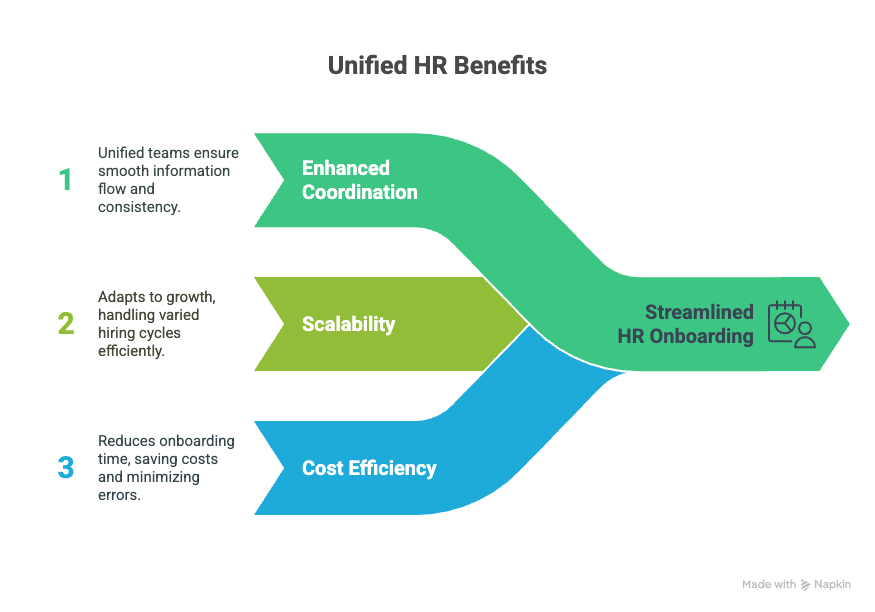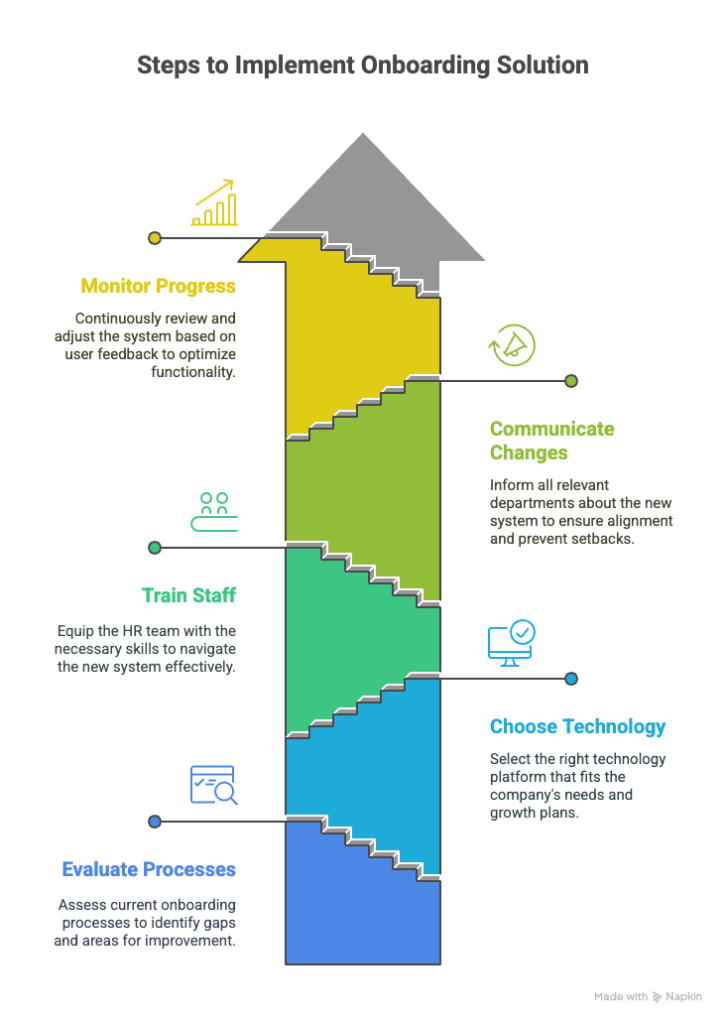In today's fast-paced business world, hiring top talent efficiently is crucial for any company's success. Integrating the screening and onboarding processes into a single cohesive approach can not only streamline hiring but also enhance the overall experience for both employees and employers. Welcome to the era of the staffing onboarding background check bundle. This all-in-one HR solution is designed to merge these traditionally distinct phases into a seamless process that benefits all parties involved.
Key Takeaways
- Streamlining hiring by combining onboarding and background checks reduces paperwork and shortens the hiring process.
- Integrated onboarding improves new hire satisfaction and retention by ensuring a smooth start.
- Automation in background checks accelerates workflows and minimizes errors by processing data more efficiently.
- Digital onboarding tools like electronic signatures and role-specific training offer convenience and customization for new employees.
- Thinking about the benefits of integrated HR systems can reveal potential improvements in efficiency and coordination for your organization.
Introduction
Hiring is tough. It often feels like a juggling act with longer-than-necessary onboarding times and clunky screening processes that throw a wrench into the works. You know the drill: background checks stall as paperwork piles up. These traditional methods can bog down even the most eager applicant's journey into their new role.
Enter the all-in-one staffing onboarding background check bundle. This approach is shifting the HR landscape by packaging the screening and onboarding phases into one streamlined process. It's gaining traction among HR professionals and staffing agencies alike because it simplifies and accelerates hiring.
This guide digs into these integrated onboarding packages, exploring how they meet today’s HR needs efficiently and effectively.
Integrating onboarding and screening processes can simplify your HR operations significantly. By combining these tasks, you reduce repetitive paperwork and minimize administrative tasks. This integration speeds up hiring, moving candidates from acceptance to active roles more smoothly. Instead of handling disparate systems, one streamlined system can consolidate these stages.
When you improve the transition from candidate to employee, it enhances their experience. A fast, efficient process leads to greater satisfaction, as new hires start feeling part of the team sooner. This can boost retention rates, since employees often appreciate a seamless start, which reflects well on the company culture.
Standardizing these processes helps maintain consistency across hires, ensuring compliance with HR regulations. This is especially important in meeting requirements set by the U.S. Department of Labor. By implementing uniform procedures, you mitigate risks and increase accountability.
Efficient, compliant, and seamless – an integrated package could be the overhaul your HR practices need.
EXPERT INSIGHT: I can recall the interviewee who stated, “I felt like I was already on the team before I began.” The moment made me realize all the more why an onboarding and background check procedure is so potent. When these two get lumped together into a concise, streamlined procedure, it says something worthwhile: We're waiting for you, and we're respecting your time. As someone having suffered through systems irritation and sluggish starts, I can promise you this—when we listen attentively, we build credibility before day one. And in today's marketplace, credibility is the final retention unit of exchange. - Charm Paz, CHRP
Key Components of a Staffing Onboarding Background Check Bundle
A staffing onboarding background check bundle streamlines hiring by combining essential processes. This section explores the core elements of such a package.
Background Check Integration
Background checks are a critical part of any hiring process. Here's what a comprehensive screening typically includes:
- Types of Checks Included: Most bundles offer criminal history searches, credit reports, and employment verification. For example, criminal background checks can prevent potential risks by revealing past convictions. Employment verification confirms previous job titles and tenure, ensuring the accuracy of applicant information.
- Automation in Screening Workflow: Automation speeds up the process and minimizes human error. For instance, automated systems automatically pull records and flag issues, reducing manual labor and allowing you to focus on more strategic HR functions.
- Data Security: Protecting candidate information is crucial. All data handled during the background check must comply with regulations like the Fair Credit Reporting Act (FCRA). Use secure, encrypted systems to prevent unauthorized access to sensitive information, bolstering trust with your new hires.
By integrating these elements effectively, an all-in-one bundle not only enhances efficiency but also ensures compliance and accuracy throughout the hiring process. This structured approach lays a strong foundation for the subsequent onboarding phase, creating a seamless transition from candidate to employee.
Onboarding Solutions
Digital documentation and electronic signatures have fundamentally changed onboarding. Paperwork used to be a bottleneck, but now, digital platforms clear the way. You can complete forms, sign contracts, and file documents online, saving time and reducing clutter.
Training is another piece of the puzzle. Interactive modules make learning engaging and straightforward. New employees can complete courses at their own pace and revisit them anytime. This approach ensures consistent understanding across the board.
Role-specific onboarding tailors the experience to individual needs. A software developer and a marketing specialist will have different priorities. Customizing onboarding ensures each employee gets what they need to hit the ground running. Think about how this focus on personalization can improve your own company’s onboarding experience.
Benefits of All-in-One HR Onboarding
Enhanced Coordination: An all-in-one HR package ensures that HR, IT, and compliance teams work together as one unit. This integration allows for a smoother flow of information, reducing miscommunications and delays. When these departments share a unified platform, consistency in information and quicker resolution of issues are more easily achieved.
Scalability: For businesses poised for growth, scalability is crucial. Integrated solutions cater to changing needs, efficiently handling an increase in hires without sacrificing quality. Whether hiring spikes seasonally or due to expansion, these solutions can adjust to varied hiring cycles without extra strain on resources.
Cost Efficiency: An integrated package trims down the time it takes to onboard new employees, which directly saves costs. Time saved translates into lower administrative expenses. Less time is spent on repetitive tasks, and errors that could lead to financial penalties are minimized. The initial investment in such solutions often pays off through reduced overheads and improved operational productivity.

Have you thought about how much time and resources you could save by coordinating these processes? Such an evaluation might reveal opportunities to optimize your current approach, potentially lowering costs while improving new employee integration.
Implementing a Background Check and Onboarding Solution
Moving to an all-in-one onboarding package involves several key steps. Start by evaluating your existing processes. Identify gaps where integration could improve efficiency. This assessment sets the foundation for a smoother transition.
Choose the right technology. Look for platforms that fit your company's scale and growth plans. Ensure the features meet your needs, such as integration capabilities and user-friendliness. Don't forget to check for good customer support. This assistance can be invaluable when issues arise.
Training your staff is crucial. Equip your HR team with the skills to navigate new systems. Hands-on workshops and regular training updates can ensure the team adapts quickly. Employees familiar with the technology can make the transition easier and faster.
Communicate changes across departments early. Inform your IT and compliance teams about the new system. This ensures everyone is on the same page and helps prevent any setbacks during implementation. Cross-departmental communication fosters a seamless adoption process.
Monitor progress after implementation. Collect feedback from users to identify any problems. Adjust processes as needed to optimize functionality. Continuous review helps keep the system efficient and aligned with company goals.

Would this solution address your current challenges? Consider these steps to ensure your integration goes smoothly and meets your business needs.
Real-World Applications and Case Studies
Incorporating integrated onboarding and background check processes isn't just a theory—it's been successfully applied across various industries. Take the case of TechFirm, a mid-sized software company that struggled with high turnover and long onboarding times. By adopting an all-in-one HR solution, they reduced their onboarding time by 50%. The streamlined process ensured that IT, HR, and compliance teams worked together seamlessly. As a result, TechFirm saw a 30% increase in new hire retention within the first year.
Healthcare is another sector where these bundles have made a difference. A hospital chain faced challenges with compliance due to the rigorous background checks necessary for medical staff. By implementing an integrated solution, they cut down on manual data entry errors, ensuring that every new employee met the required standards quickly and efficiently. This not only improved compliance but also enhanced the overall patient care experience by ensuring staff were fully prepared for their roles from day one.
Manufacturing companies often have different onboarding needs due to varied roles within the plant or factory. A manufacturing company utilized role-specific onboarding packages tailored to different departments. For example, machine operators received specialized safety training modules as part of the onboarding package. The tailored approach contributed to a safer work environment and a significant reduction in safety incidents during the first few months of employment.
These examples illustrate how customized and integrated onboarding bundles meet the specific needs of different industries. How can your organization benefit from streamlined processes, and what unique challenges can an integrated approach solve for you?
Common Challenges and How to Overcome Them
When you shift to an integrated onboarding package, a few hurdles can pop up. One common issue is data integration. Mixing new systems with existing software can create headaches. You might encounter mismatched data formats or missing links between systems. To tackle this, thorough vetting of compatibility between new and old systems is crucial. Test runs can help identify and resolve issues before full-scale implementation.
Change management poses another challenge. People don’t usually like changing how they work. Resistance is natural. Clear communication and training can ease this process. Explain the benefits of the new system, and make sure training is practical and hands-on. This builds confidence and buy-in from your team.
Keeping up with technology and regulations is key to long-term success. HR and compliance landscapes change rapidly. Regularly review your systems and processes to ensure they align with current regulations and tech standards. Stay proactive by setting a schedule for audits and updates.
Facing these challenges head-on can clear the path to reaping the benefits of an integrated onboarding system. Are you prepared to tackle these obstacles with the right strategies?
Future Trends in Screening and Onboarding
Emerging technologies are reshaping HR onboarding solutions with a focus on predictive analytics and AI. These tools can analyze patterns to anticipate which candidates will excel in certain roles, potentially transforming the hiring process. Think about how your organization could leverage AI to enhance decision-making and reduce time spent on repetitive tasks.
Remote work is another factor influencing onboarding. As more companies adopt flexible work arrangements, remote onboarding solutions become vital. Digital platforms enable virtual meet-and-greets and online training, allowing new hires to integrate into the company culture from anywhere. Consider whether your current processes support remote workers effectively.
Continuous improvement remains a priority. Regularly reviewing and refining your onboarding processes keeps them aligned with technological advancements and regulatory shifts. How often do you assess your systems to ensure they meet the latest industry standards?
Staying agile in response to these trends will likely enhance your company’s ability to attract and retain talent. Evaluate your current offerings and consider incorporating these forward-thinking strategies to maintain a competitive edge in the ever-evolving HR landscape.
Conclusion
Adopting an integrated approach to onboarding and background checks can mark a substantial advancement for your HR processes. Bundled solutions streamline the hiring process, reduce errors, and save costs by minimizing administrative tasks. They foster seamless communication between departments, ensuring that everyone from HR to IT is aligned on each new hire's journey.
Consider how enhancing the candidate's experience contributes to retention. When the transition from offer to employment is smooth, new hires feel valued and supported from day one. Standardization also ensures you maintain compliance with evolving regulations, reducing potential legal risks. This cohesive approach offers flexibility, adapting as your business grows and scales.
Reflect on your current onboarding system. Are you facing issues with fragmented processes, extended timelines, or compliance concerns? It might be time to rethink your strategy. Evaluate how bundled solutions can transform your hiring approach, providing robust frameworks that can help you keep pace with change.
Explore industry case studies and technological advancements in predictive analytics and AI, as these areas are rapidly reshaping HR practices. Training and a continuous improvement mindset will empower your team to leverage these tools effectively. By investing in these technologies, you prepare your company for future demands and foster a culture of innovation.
Investigate the trends shaping the future of remote onboarding, particularly as remote work continues to surge. Considering how these innovative solutions can meet your needs might be the pivotal step your company requires for future-ready hiring practices.
To continue your journey into optimizing hiring systems, explore our guide on the most common background check questions.
Frequently Asked Questions (FAQs)
What is bundled screening and onboarding?
Bundled screening and onboarding is the process of integrating background checks with the employee onboarding process. This approach allows you to streamline both tasks, ensuring a seamless transition from candidate to employee.
How does combining background checks and onboarding reduce time-to-hire?
By integrating these processes, you eliminate redundant steps, leading to less back-and-forth and quicker results. This efficiency helps reduce the overall time-to-hire, allowing new hires to start sooner.
What tools support all-in-one onboarding for staffing firms?
Tools like Applicant Tracking Systems (ATS) and HR software platforms are popular. They combine background checks, e-signatures, and document management to create a smooth onboarding experience.
Is bundling background checks and onboarding compliant with FCRA and E-Verify?
Yes, it can be compliant when correctly implemented. Ensure your processes align with the Fair Credit Reporting Act (FCRA) and E-Verify regulations to maintain legal standards.
What are the benefits of all-in-one onboarding solutions?
These solutions simplify paperwork, improve communication, and reduce errors. You gain efficiency, saving time for both HR and new employees.
How can automation improve the onboarding process?
Automation reduces manual tasks, leading to fewer errors and faster processing. This allows HR teams to focus on more strategic activities.
What challenges might you face with bundled screening and onboarding?
Potential challenges include software integration issues and ensuring data compliance. Choosing the right tech partner can mitigate these risks.
How does bundling impact the candidate experience?
When done right, bundling provides a smooth and efficient experience. Candidates appreciate a seamless transition with fewer repetitive tasks.
Can small businesses benefit from all-in-one onboarding solutions?
Absolutely. Regardless of size, companies see improved efficiency and reduced errors, making it an advantageous approach for any business.
How can you ensure data security in bundled processes?
Work with reputable software providers that prioritize data protection. Regularly review your security practices to safeguard personal information.
Definitions
Hiring and on-boarding is as much concerning details as it is the larger landscape. An understanding of the basic HR essentials of on-boarding, background screening, compliance, and employment verification can be the difference between smooth sailing and expensive mistake. The section that follows describes key terms that you must familiarize yourself with as you work at building an effective, practical, and compliant hiring process. Finessing what you already have in operation or beginning it all anew, you start at the foundation.
Onboarding
Onboarding is the process of integrating a new employee into your organization. It covers everything from completing employment forms and setting up workstations to introducing team members and assigning initial tasks. A clear, well-planned onboarding process helps employees understand their roles faster and feel welcomed. Think about how your current process affects employee productivity and early engagement.
Background Check
A background check is a review of a candidate’s legal, financial, and employment history before hiring. It typically includes criminal record searches, credit reports, and verification of past employment and education. The goal is to confirm the accuracy of the information provided and identify any risks. Are your current checks both thorough and timely?
Employment Verification
Employment verification confirms a candidate’s previous job titles, tenure, and sometimes salary. It ensures the applicant’s work history is accurate and truthful. This step helps reduce the chances of hiring someone based on exaggerated or false credentials. Are you confident in how you're verifying past employment?
Compliance
Compliance refers to following legal and industry regulations when hiring employees. This includes laws related to background checks (like the Fair Credit Reporting Act), equal opportunity employment, and paperwork retention. Consistent compliance protects your company from legal issues. Are your HR practices meeting current legal standards?
Electronic Signatures
Electronic signatures allow documents to be legally signed online. They replace physical paperwork, making the hiring process faster and easier. Most platforms timestamp and secure each signature for accuracy and traceability. Think about how much time your team could save with digital agreements.
References
Still have questions?
Get in touch with our team today for a personalized demo and discover how our tailored volume pricing and packages can drive results for your business!
How useful was this page?*
Note: your comments are anonymous. We use them to improve the website. Do not include any personal details.
Visit our FCRA Compliance Tool or leave a message here if you need a response.
From the blog Explore the GCheck Content Hub

Level 2 Background Check for Childcare: Complete Compliance Guide for Employers
17 Dec, 2025 • 18 min read
How to Get a TWIC Card: Complete Application Guide
17 Dec, 2025 • 28 min read
Pharmacy and Medical Delivery Driver Background Checks: Compliance Guide
17 Dec, 2025 • 24 min readThe information provided in this article is for general informational and educational purposes only and should not be construed as legal advice or a substitute for consultation with qualified legal counsel. While we strive to ensure accuracy, employment screening laws and regulations—including but not limited to the Fair Credit Reporting Act (FCRA), Equal Employment Opportunity Commission (EEOC) guidelines, state and local ban-the-box laws, industry-specific requirements, and other applicable federal, state, and local statutes—are subject to frequent changes, varying interpretations, and jurisdiction-specific applications that may affect their implementation in your organization. Employers and screening decision-makers are solely responsible for ensuring their background check policies, procedures, and practices comply with all applicable laws and regulations relevant to their specific industry, location, and circumstances. We strongly recommend consulting with qualified employment law attorneys and compliance professionals before making hiring, tenant screening, or other decisions based on background check information.


